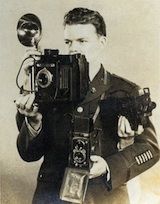- Forum
- Photography and Camera Forum
- Taking the Photo | Editing | The art of Photography!
- Editing and Presentation
- A way to shoot RAW and keep your in camera settings when using lightroom.
A way to shoot RAW and keep your in camera settings when using lightroom.
-
 Topic Author
Topic Author
- Justin White Photography
- New Kid On The Block
-
- Nikon D3000, Canon Powershot A630
- Followers: 28
- Posts: 12
-
Points:
0
Post #133315
Well, this is because Lightroom is an Adobe product and doesn't exactly loose your settings just interprets it in the best way it knows how from the information it is given in the RAW file.
So, in order to keep your in camera settings you would have to use a Nikon program like ViewNX and then save the file as a .TIF file. These files are loss-less and will keep all information without degradation to the photo while editing.
Then you can just import into Lightroom and you have all your settings from your camera. You can then do your regular editing and if you have more advanced editing you can move your editing to Photoshop, which is very easy considering Lightroom was made to work with Photoshop.
This is what i found out from a bit of research on the internet and it's something that i had been wanting to know about since i started using Lightroom in my workflow...figured I would pass on the info and save you guys the trouble.
Hope this helps!
-

- MLKstudios
- Banned
-
- D800 ;-)
- Followers: 72
- Posts: 4480
-
Points:
2
Post #133327
However a TIFF is not a RAW file. When you edit a TIFF you change the pixels. Editing a RAW file leaves the original pixels alone. RAW edits are non-destructive.
I use Adobe's DNG converter first. Then add my own edits which are contained within the DNG file.
The advantage of RAW (for me) is the original camera settings aren't that important. They can easily be manipulated in post. That's the beauty of it.
Matthew
Matthew L Kees
MLK Studios Photography School
www.MLKstudios.com
[email protected]
"Every artist, was once an amateur"
-
 Topic Author
Topic Author
- Justin White Photography
- New Kid On The Block
-
- Nikon D3000, Canon Powershot A630
- Followers: 28
- Posts: 12
-
Points:
0
Post #133335
You seem to know a lot about this and have been so helpful through the past couple days I've been here...glad we have you on here.
So, what would you suggest If I were to keep using Lightroom in my workflow. Just keep it as the RAW file and edit as i was in the first place? Isn't Lightroom nondestructive with any file?
-

- MLKstudios
- Banned
-
- D800 ;-)
- Followers: 72
- Posts: 4480
-
Points:
2
Post #133338
I suggest doing what I do...
1. Import NEF (or CR2) from the card to a folder on your computer.
2. Import them into Lr as DNG files -- here you can add data to the EXIF, like your copyright info, keywords for searching, etc. and place them on external drive(s).
3. Edit the DNG.
HTH
Matthew L Kees
MLK Studios Photography School
www.MLKstudios.com
[email protected]
"Every artist, was once an amateur"
-

- Henry Peach
- Apprentice
-
- I currently use a 5DII or Sony Nex-3 most of the time.
- Followers: 50
- Posts: 2925
-
Points:
16
Post #133354
Personally I don't expect the raw file to look like the finished photo any more than I expected my negs to look like the finished photo. If I wanted the in-camera processing look I'd just shoot jpeg. Raw is for going beyond what the in-camera processing is capable of.
-

- MLKstudios
- Banned
-
- D800 ;-)
- Followers: 72
- Posts: 4480
-
Points:
2
Post #133359
Yes, you can customize settings for each model camera you own, or the ISO used and more. But, no it isn't reading every bit of EXIF data (or maybe it's interpreting it slightly differently) as Nikon's own software is capable of doing.
It's their only advantage -- keeping the RAW formats proprietary.
I think the Adobe engineers do a pretty good job reversing them though.
Matthew
Matthew L Kees
MLK Studios Photography School
www.MLKstudios.com
[email protected]
"Every artist, was once an amateur"
-

- Henry Peach
- Apprentice
-
- I currently use a 5DII or Sony Nex-3 most of the time.
- Followers: 50
- Posts: 2925
-
Points:
16
Post #133366
-

- MLKstudios
- Banned
-
- D800 ;-)
- Followers: 72
- Posts: 4480
-
Points:
2
Post #133370
Never LCD. Histogram!!
Matthew L Kees
MLK Studios Photography School
www.MLKstudios.com
[email protected]
"Every artist, was once an amateur"
-

- Henry Peach
- Apprentice
-
- I currently use a 5DII or Sony Nex-3 most of the time.
- Followers: 50
- Posts: 2925
-
Points:
16
Post #133372
Justin White Photography wrote: Isn't Lightroom nondestructive with any file?
Yes, but a raw file allows access to the information gathered by the sensor in it's most unprocessed form available. A tiff is a processed photo. So before you get to Lightroom you have discarded some of the original information by converting it to a tiff.
-

- MLKstudios
- Banned
-
- D800 ;-)
- Followers: 72
- Posts: 4480
-
Points:
2
Post #133375
RAW is akin to developing the negative yourself. Hence the DNG (Digital Negative) format.
Matthew L Kees
MLK Studios Photography School
www.MLKstudios.com
[email protected]
"Every artist, was once an amateur"
-
 Topic Author
Topic Author
- Justin White Photography
- New Kid On The Block
-
- Nikon D3000, Canon Powershot A630
- Followers: 28
- Posts: 12
-
Points:
0
Post #133397
I've heard a lot of controversy between the RAW and DNG file formats. Pros and Cons so a lot of people say DNG isn't going to be around to long. It is still fairly new considering other file formats.
Maybe I should start a thread about that and see what everyone thinks about the two and what they use more.
-

- MLKstudios
- Banned
-
- D800 ;-)
- Followers: 72
- Posts: 4480
-
Points:
2
Post #133398
Only 2 people thought this comment was worthwhile.
Matthew L Kees
MLK Studios Photography School
www.MLKstudios.com
[email protected]
"Every artist, was once an amateur"
-

- Henry Peach
- Apprentice
-
- I currently use a 5DII or Sony Nex-3 most of the time.
- Followers: 50
- Posts: 2925
-
Points:
16
Post #133489
Justin White Photography wrote: I've heard a lot of controversy between the RAW and DNG file formats. Pros and Cons so a lot of people say DNG isn't going to be around to long. It is still fairly new considering other file formats.
How hard is it to open a gif? Check out the long list of file extensions that no one ever uses anymore, but Adobe/Windows/Mac imaging software can still handle. It's easy to include code to read/open old files. If you can get to the internet there won't ever be a problem opening, reading, and converting old files.
Raw is not a standardized file format like gif, jpeg, tiff, etc... Raw files change from camera to camera within the same manufacturer's line of gear (don't be fooled because they keep the extension the same). DNG is Adobe's attempt to standardize the raw file format. DNG is older than the raw files used by Canon and Nikon's latest DSLRs. Although I don't anticipate ever having a problem with Canon's multitude of different raw files, I would expect to have compatibility problems with the camera manufacturers' raw files before I have those problems with DNG.
-
 Topic Author
Topic Author
- Justin White Photography
- New Kid On The Block
-
- Nikon D3000, Canon Powershot A630
- Followers: 28
- Posts: 12
-
Points:
0
Post #133606
- Forum
- Photography and Camera Forum
- Taking the Photo | Editing | The art of Photography!
- Editing and Presentation
- A way to shoot RAW and keep your in camera settings when using lightroom.
Latest Reviews
The Olympus Pen E-P7 is an affordable micro four thirds mirrorless camera with 4K video capabilities, a 20.3MP sensor, and 121 focus points, making it a solid entry-level camera for beginners.
The Panasonic G9 II is a 25.2-megapixel micro four thirds camera with numerous features that make it punch out of its weight class, like 779 AF points, 5.8K video, and weather sealing.
The Fujifilm XT5 is a 40MP mirrorless camera capable of 6.2K video at 30p. With those specs, it’s an ideal choice for photographers needing a camera to pull double duty for imaging and video.
The Canon EOS R100 is an entry-level mirrorless camera introduced in 2023. But just because it’s an entry-level camera doesn’t mean it’s a bare-bones camera. Find out why in this review!
Forum Top Posters
-
1Scotty 2 posts
-
2katherineb... 2 posts
-
3Shadowfixe... 1 post
-
4James F 1 post
-
5Esseff 1 post
Latest Articles
Tree photography is an interesting genre of landscapes that use the size, shape, and texture of trees as the primary element of interest. With these quick tips, you can master the art of photographing trees!
Auto white balance is a camera setting that adjusts the color temperature of your images automatically. It often works well, but you should know a few tips to fix problems it might cause, too.
The Canon EOS 5D Mark III might be more than a decade old, but it still has the chops to be a quality camera for photographers in 2024.
Starting a photography business can be a daunting task. There is a lot to do, and many mistakes can be made. This guide helps you minimize mistakes and maximize your success!
The Canon 6D Mark II might be an older DSLR, but that doesn’t mean it isn’t a good option for 2024. In fact, this budget-friendly camera is a powerhouse for stills and videos.
In this guide to the bokeh effect, you’ll learn what bokeh is and the factors involved in creating it. You’ll also explore some beautiful example images to spark your creativity with bokeh!
Upgrade your kit in 2024 with the best intermediate camera on the market! The question is, what camera fits the bill? We’ve got three top options for you to choose from in this buyer’s guide.
The best photography jobs right now are a mix of tried-and-true gigs like wedding photography and new jobs highlighting AI’s capabilities, travel, and videography.















